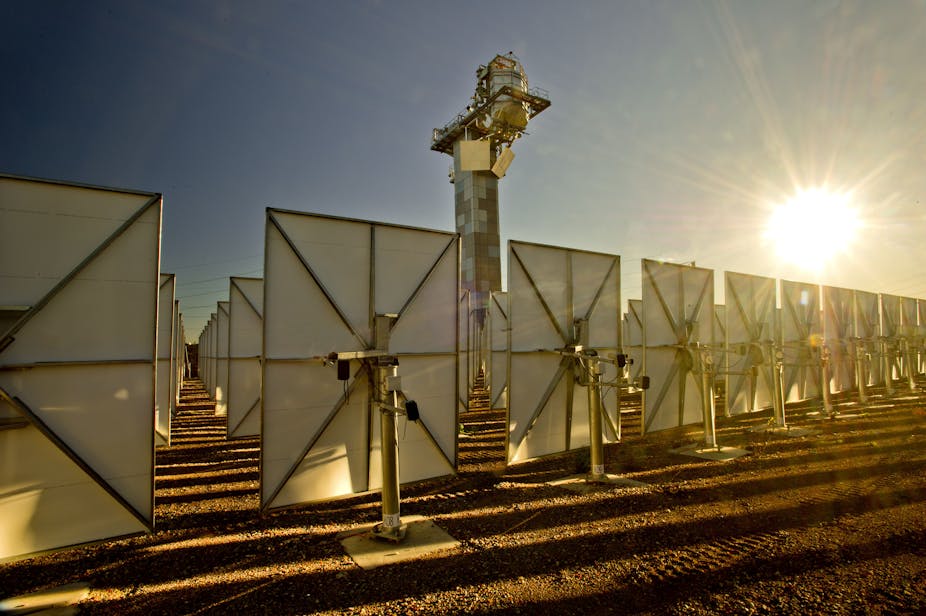Most people are familiar with solar energy generated by photovoltaic (PV) solar cells; they are the tiny PV cells on your calculator or the large PV installations that many people are installing on their household roof tops. But you may know less about solar thermal energy.
PV cells absorb solar energy to generate electricity directly. Solar thermal technologies use the sun’s energy to generate heat. This heat can then be used for a variety of processes including generating electricity.
When you dry your washing on the line, or heat water with a solar hot water system, you’re using solar thermal energy.
To generate higher temperatures from this heat you “concentrate” the solar radiation using a lens or a mirror to focus it onto a smaller area. With the right type of focusing system, solar radiation can be turned from something capable of merely drying clothes, to powering turbines to generate enough energy to power a small town.
Is solar power Australia’s future energy solution?
Certainly Australia has abundant solar energy resources, with the highest average solar radiation per square metre of any continent in the world.
The amount of solar radiation falling on Australia each year (approximately 58 million petajoules) is approximately a hundred times the world’s total annual energy consumption (Source: IEA 2009 World Energy Outlook and ABARE Australian Energy Resource Assessment).
However there is no single solution that will provide us with the amount of clean energy we need, when we need it, at a competitive price. As in any future investment strategy we need a portfolio approach to create a diverse set of possibilities.
In a recent report commissioned for the Garnaut Climate Change Review 2011 Update, CSIRO provided a technical analysis of the potential for concentrated solar power (CSP) to provide low cost, renewable electricity in Australia. This outlines the advantages and opportunities for advancing this form of solar technology.
The report found that CSP:
has the potential to become a low cost technology, using solar towers in particular
has the potential to be integrated with low cost thermal storage to provide renewable power during peak demand times (during the evening)
can be combined with fossil fuels such as natural gas.
The path to commercial solar thermal
In June 2011 Prime Minister Julia Gillard officially opened CSIRO’s international hub for researching, developing and commercialising solar thermal technologies at the CSIRO National Solar Energy Centre in Newcastle, New South Wales.
With a 30 metre high solar tower surrounded by 450 custom designed mirrors (heliostats), the 1.2MW(thermal) facility can generate temperatures up to 1500°C. Although used for research, a site this size could generate enough electricity to power 200-300 homes.
The new solar tower compliments the current solar tower at the CSIRO site that was built in 2006 to develop and test solar fuel called SolarGas™. This combines solar radiation and natural gas, creating a synthetic gas that embodies around 25% solar energy. It can be used for electricity production, solarised liquid fuels, and as a feed stock in numerous industrial processes such as ammonia production.
In the next stage of CSIRO’s solar thermal research, scientists will use the facility to develop and test a solar air turbine (known as the solar Brayton cycle) to generate electricity from air and sunshine alone.
The solar Brayton cycle technology is one way to make concentrated solar power commercially feasible in the near-term in Australia. It can be co-fired with natural gas where high capacity is needed, it is suitable for distributed generation at the 1-10MWe range and it doesn’t need water.
It has a good balance between risk and financing for the Australian market. It also has existing markets: large, remote mining sites using expensive diesel-fired electricity generation with which it can compete.
Along with the existing adjacent solar tower, the facility will also be used to research, develop and test solar energy storage systems, high temperature steam generation and thermoelectric generators.
Concentrated solar power has significant potential to become a major contributor to Australia’s energy mix. Our research is looking at how to reduce costs by improving plant efficiency via higher temperatures. We are also investigating how to significantly reduce the capital costs with high performance, low cost heliostat systems.
The establishment of CSIRO’s international solar thermal research hub is a major step towards achieving these goals.

